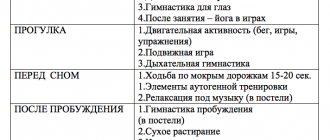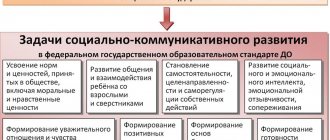Health-saving activities of preschool teachers
We offer creative development for preserving health in preschool educational institutions. This material can be useful for both teachers and parents. This development is aimed at preserving and strengthening the health of the younger generation, preparing the child for a healthy lifestyle.
Content
Introduction
I. Health-saving activities of preschool teachers as a psychological and pedagogical problem;
1.1. The concepts of “health” and “health-saving activities of preschool educational institutions”;
1.2. Health-saving technologies in the educational process of preschool educational institutions;
1.3. Features of the development of health-preserving competence in preschool children;
II. Health-saving activities of preschool teachers and families;
2.1.Creation of a health-preserving environment in a kindergarten;
Mastering modern technologies in the educational process.
2.2.Use of health-saving technologies in conditions of cooperation between preschool educational institutions and families.
Conclusion.
Bibliography.
Application.
Introduction
In modern conditions, the social and pedagogical importance of preserving the health of a child is increasing. Research in recent years has shown a deterioration in the health of the Russian population. The mortality rate is increasing, the birth rate is falling, the problem of poverty is worsening, and a significant part of the country's population is in a state of chronic distress. These negative trends acutely affect the health of the younger generation. According to D.I. Zelinskaya, over the last decade there has been a deceleration, i.e. slowdown in the rate of development of young Russians. The number of healthy children and adolescents barely reaches a fifth of their total number; about a third of children entering school already have a chronic pathology.
Preparing a child for a healthy lifestyle based on health-saving technologies should become a priority in the activities of every educational institution, especially for preschool children. According to the Ministry of Health and Industry and the State Committee for Epidemiological Surveillance of Russia, only 14% of children are practically healthy, 50% have functional abnormalities, and 35-40% have chronic diseases. The number of children who, already in primary school, are unable to master the program in the allotted time and to the required extent ranges from 20% to 30% of the total number of students.
It is necessary to improve the education system, intensify children's health-preserving activities, implement an individually differentiated approach to instilling the basics of a healthy lifestyle, training and development of children in preschool and family settings.
Much attention must be paid to the organization and pedagogical support of the formation of useful habits, attitudes towards a healthy lifestyle, understanding the intrinsic value of health and ways to preserve it.
The purpose of the development is to consider the features of the health-preserving activities of preschool teachers in working with children and parents.
Tasks:
1. consider the essence of health-saving technologies and their application in the educational process of preschool educational institutions;
2. characterize the areas of health-preserving activities of a teacher in a preschool educational institution;
3. reveal the features of the activities of parents and teachers of preschool educational institutions to form the foundations of a healthy lifestyle for preschool children.
I. _ Health-saving activities of preschool teachers as a psychological and pedagogical problem
1.1. The concepts of “health” and “health-saving activities of preschool educational institutions.”
Health is a complex concept. It depends on the socio-economic status of children, the environmental situation in their places of residence, the quality of food, medical care, preventive work with children by doctors and teachers, and the system of health institutions.
It is known that the World Health Organization defines health “as a state of complete physical, mental and social well-being and not merely as the absence of disease or infirmity.” This formulation is rightly criticized for the idealization of the goal, the subjective understanding of well-being, the static approach to health and the absolutization of complete well-being, which leads to a decrease in the stress of the body and its systems, and therefore to a decrease in resistance and a precondition for ill health [4]. Some researchers see health as the realization of a person’s specific abilities to manifest the body’s reserves, to sustainability, to resistance, self-preservation and self-development [6]. It is obvious that the formation of such abilities in the younger generation is becoming one of the highest priority tasks in the practical activities of Russian teachers today.
An analysis of definitions of health shows that six of its signs are most often found:
- absence of disease;
- normal functioning of the body;
— harmonization of the body and the environment;
— a person’s ability to fully perform basic social functions;
- complete physical, mental and social well-being;
— human adaptation to an increasingly complex and changing environment.
The most complete definition is A.G. Shchedrina [13], who, from the standpoint of a systems approach, proposes to consider health as an integral multidimensional dynamic state (including its positive and negative indicators) in the process of implementing the genome (a set of genes) in a specific social and environmental environment, allowing a person to realize his biological functions to varying degrees. and social functions.
Considering health as a single whole, scientists at the same time identify interconnected parts in it: physical and spiritual; physical, mental and social; physical, psycho-emotional, intellectual, social, personal and spiritual. Following I.I. Brekhman, G.K. Zaitsev, V.V. Kolbanov [15], we adhere to a three-component structure of health, which includes physical, mental and social elements.
By the physical component of health, researchers mean how the body functions, all its organs and systems, and the level of their reserve capabilities. This aspect of health also includes the presence or absence of physical defects and diseases, including genetic ones (S. Shapiro).
From the point of view of such WHO experts as Sortarius, M. Jehed, mental health is the normal course of mental processes, characterized by the absence of severe mental disorders and the presence of certain reserves of human strength, thanks to which he can overcome unexpected stress or difficulties that arise in exceptional circumstances, as well as a state of balance between a person and the world around him, harmony between him and society, the coexistence of the ideas of an individual with the ideas of other people about objective reality [7]. Mental health, according to experts, includes such components as a positive attitude towards oneself, optimal development, growth and self-actualization of the individual, mental integration (authenticity, congruence), personal autonomy, realistic perception of others, and the ability to adequately influence them.
According to S. Shapiro, the social component of health is the individual’s awareness of himself as a male or female subject and the interaction of the individual with others. This element reflects the way of communication and relationships with different groups of people (peers, colleagues, parents, neighbors), i.e. with society. In our opinion, the formation of a system of value relations, readiness for self-determination of life path, as well as social activity and the ability to social adaptation are important for the social component of human health.
Educators, psychologists and social workers are unanimous in the opinion that, in an environment of complex and ambiguous development of market relations in the country, negative trends in raising children have intensified. Such manifestations of an unhealthy personality as dependence on bad habits, maladjustment of behavior, conflict, hostility, inadequate perception of the surrounding world, passive life position, avoidance of responsibility for oneself, loss of faith in one’s abilities, weakening of will, egocentrism, passivity, loss of interest have become widespread. and love for loved ones, hypertrophied (or vice versa) self-control, etc.
Identification of the composition and disclosure of the characteristics of social health criteria seem to be key issues, the degree of awareness of which largely determines the practical solution by teachers of the above-mentioned problem. Summarizing the statements of scientists, we present a list of criteria for the social health of an emerging personality. First of all, these include the need for security, affection and love (according to A. Maslow), unselfishness, interest in the world around us, adequate perception of social reality, adaptation to the physical and social environment, focus on socially useful work, altruism, democratic behavior , the ability to interact with representatives of different social groups (including adults and peers), etc. [9].
Teaching how to take care of your health and lead a healthy lifestyle is the task of parents and educational institutions. This can be expressed through direct teaching of children the basic techniques of a healthy lifestyle (preventive methods - health, finger, breathing exercises, self-massage, etc.); instilling in children basic hygiene skills (washing hands, using a handkerchief when sneezing and coughing, etc.); through health-developing technologies of the learning and development process using physical education and active breaks; ventilation and wet cleaning of premises; aromatherapy, vitamin therapy; functional music; alternating activities with high and low activity; through specially organized physical activity of the child (health-improving physical education classes, outdoor games); in the process of rehabilitation measures (herbal medicine, inhalation, physical therapy); mass recreational events (themed health holidays, going out into nature); and also in working with families and teaching staff.
The health-saving activities of preschool educational institutions include a whole system. This system can be presented in the form of the following sections:
1. Comprehensive medical, psychological and pedagogical assessment of the level of physical development and health of children, which includes diagnostic measures to assess and monitor the health status of kindergarten students by various specialists.
2. Medical and health work covers the areas of healing and hardening through a set of activities.
3. Physical education and development work with children reveals a complex of physical education activities, various types of specially organized activities.
4. Psychological and pedagogical activities highlight the system of organizing psychological support for children with methods and techniques for creating a favorable emotional and psychological climate.
5. Health-saving components in the organization of the educational process.
6. Resource support for health-saving activities in kindergarten [11].
Comprehensive medical, psychological and pedagogical assessment of the level of physical development and health of children
A comprehensive medical, psychological and pedagogical assessment of the level of physical development and health of children is a basic component in the holistic system of health-preserving activities of a kindergarten.
The conceptual provisions that determined the development of a system of health-preserving activities in kindergarten are:
1. An integrated humanitarian approach to child health [5].
2. Approaches to organizing physical education and health work with a predominance of cyclic, primarily running, exercises and especially their combinations.
3. Contents, forms of developmental motor play activities and principles of health-improving work with children [7].
4. Rational combination of different types of activities [8].
5. Individually differentiated principle of organizing motor activity [1].
The structuring of the educational process in the institution is based on a health-preserving dominant and the use of new forms and methods of working with children in the educational process within the framework of a single comprehensive health-improving and developmental space.
The contents of this work include:
· monitoring the state of development;
· determination of health level;
· observation of the formation of systems, body functions and motor skills of preschool children.
Medical and health work
The work is carried out through the organization of hardening and therapeutic activities. The main goal is to prevent and reduce acute and chronic morbidity in children. To harden children in kindergarten, environmental factors are used - air, water, sun.
These factors and means of hardening are used in kindergarten both separately and comprehensively, the main thing is to follow an individual approach, take into account the recommendations of medical specialists and develop continuity with parents.
Physical education and development work
Only with a systematic and scientifically based approach does physical education become an effective means of preserving and strengthening the health of children and improving their physical development.
Physical education and health work with children is carried out through various types of specially organized activities, where personal development technologies and integrated forms of organizing motor activity are used. Physical education classes as the most important form of physical education and health work involve taking into account the functional state of health of each child and his level of preparedness. They are built on the content provided for by the programs implemented by the institution.
The purpose of physical education work is the formation of the motor sphere and the creation of psychological and pedagogical conditions for the development of children’s health based on their creative activity.
Optimal conditions for the development of physical culture created in a preschool institution solve a complex of health-improving, educational and educational tasks.
The content is based on the principles of developmental pedagogy of health improvement by V. T. Kudryavtsev.
Psychological and pedagogical activities
Since physical health forms an inextricable unity with mental health, the following goals and objectives are solved in a preschool institution, taking into account the complexity and multifaceted nature of this concept.
Goals: mental health; creating conditions that promote emotional well-being and ensure the free and effective maximum development of each child.
Tasks:
· creating a safe psychological space, developing a sense of confidence and psychological comfort;
· formation of the optimal status of each individual child in the interacting group, ensuring emotional well-being;
· creating conditions for the creation and resolution of personal problems and interpersonal conflicts.
Health-saving components
By creating a developmental space for children's health, the efforts of all specialists are combined: speech therapists, educators, educational psychologist, director of a theater studio, physical education instructor, music director.
The structuring of the educational process in the institution is based on the health-preserving dominant:
· introduction of therapeutic measures (stabilizes the health of children, reduces the level of neuroticism, creates harmony of the child’s mind and feelings, increases endurance to stress in a healthy daily routine and the organization of a flexible regime in bad weather);
· the use of binary, polynarious activities (as a result of which children feel in a comfortable, psycho-emotional state, which allows them to increase motivation for learning activities and confidence in themselves and their capabilities);
· personality-oriented education (reduces children’s complexes, allows them to use basic socionic attitudes, select developmental technologies for a specific group, determine the basic psychotype of a given children’s group);
· integration of the content of educational activities in a single field of knowledge (through the method of thematic immersion and gaming activities).
Resource support for health-saving activities in kindergarten
Subject-spatial support.
The solution to children's health problems is also facilitated by the creation of a subject-spatial environment for the child to endlessly demonstrate his growing capabilities.
The kindergarten's material and technical base includes the following spaces: specially equipped physical education and music rooms, a medical unit, speech therapy rooms designed in accordance with hygienic requirements, a psychologist's office, and group rooms.
Regulatory, legal and methodological support.
The primary basis of the system of scientific and methodological support for health-preserving activities is the legal and regulatory framework. It includes legislation, Russian state and regional laws, regulations, letters and instructions.
Scientific and methodological support for health-preserving activities are programs in the following areas.
1. Protecting and promoting the health of preschool children.
2. Physical education and development work.
3. Psychological support.
Staffing.
Protecting the life and health of children is one of the most important areas of work of a preschool institution. The health improvement system includes, as an indispensable condition, careful attention to the health of children and all employees. For the most effective organization of health-preserving measures, job descriptions of both teachers and kindergarten specialists should include job responsibilities of a health-improving nature.
1.2. Health-saving technologies in the educational process of preschool educational institutions
In recent years, we have to talk about the need to use health-saving pedagogy. At the same time, health-saving pedagogy cannot be expressed by any specific educational technology. At the same time, the concept of “health-saving technologies” combines all areas of activity of an educational institution to form, preserve and strengthen the health of students.
Health-saving technology is: the conditions for a child to stay in kindergarten (lack of stress, adequacy of requirements, adequacy of teaching and upbringing methods); rational organization of the educational process (in accordance with age, gender, individual characteristics and hygienic requirements); compliance of educational and physical activity with the age capabilities of the child; necessary, sufficient and rationally organized motor mode.
The teacher, possessing modern pedagogical knowledge, in close cooperation with students, with their parents, with medical workers, with colleagues, plans his work taking into account the priorities of preserving and strengthening the health of participants in the pedagogical process. However, only then can we say that the educational process is carried out using health-saving educational technologies if the implementation of the pedagogical system used solves the problem of preserving the health of children and teachers.
The fundamental goal of health-saving educational technologies is to provide children with the opportunity to maintain health during their stay in a preschool educational institution, to develop in them the necessary knowledge, skills and abilities regarding a healthy lifestyle, and the use of acquired knowledge in everyday life.
To implement the educational process based on health-saving technologies, it is necessary to highlight the patterns of the pedagogical process, which are expressed in the basic provisions that determine its organization, content, forms and methods, that is, principles that should contribute to the prevention, diagnosis and correction of children’s health; development of cognitive activity of pupils; humanization of education.
The principles act in organic unity, forming a system that includes general didactic principles and specific principles that express the specific laws of health improvement pedagogy.
Specific principles include:
1. The principle of no harm.
2. The principle of the triune concept of health (the unity of physical, mental and spiritual-moral health).
3. The principle of repetition of skills and abilities in order to develop dynamic stereotypes.
4. The principle of gradualism, which assumes continuity from one stage of education to another.
5. The principle of accessibility and individualization has its own characteristics in the health-improving orientation of health-saving educational technologies. The principle of individualization is carried out on the basis of general laws of training and education. Based on individual characteristics, the teacher comprehensively develops the child, plans and predicts his development.
6. The principle of continuity expresses the laws governing the construction of health improvement pedagogy as an integral process. It is closely related to the principle of systematic alternation of loads and rest.
7. The principle of cyclicity. The principle of cyclicity contributes to streamlining the process of healing pedagogy. It consists of a repeating sequence of lessons, which improves the child’s preparedness for each subsequent stage of learning.
8. The principle of taking into account the age and individual characteristics of pupils. This principle contributes to the formation of motor skills, the development of the child’s motor abilities, and taking into account the functional capabilities of the preschooler’s body.
9. The principle of comprehensive and harmonious development of the individual. This principle is of utmost importance, as it promotes the development of psychophysical abilities, motor skills and abilities, carried out in unity and aimed at the comprehensive physical, intellectual, spiritual, moral and aesthetic development of the child’s personality.
10. The principle of health-improving orientation solves the problems of strengthening the child’s health during his stay in a preschool educational institution.
11. The principle of an integrated interdisciplinary approach involves close interaction between teachers and medical workers.
12. The principle of forming responsibility in children for their health and the health of others.
13. The principle of connecting theory with practice calls for persistently teaching preschoolers to apply their knowledge on the formation, preservation and promotion of health in practice, using the surrounding reality not only as a source of knowledge, but also as a place for their practical application [9].
To achieve the goals of health-saving technologies, it is necessary to determine the main means of training and education: means of motor orientation; healing powers of nature; hygienic. The integrated use of these funds allows for the high-quality use of health-saving approaches in the educational process of preschool educational institutions.
Motor-oriented means include motor actions that are aimed at implementing health-saving approaches. This is movement; physical exercise; physical education minutes; emotional releases and “moments of peace”; gymnastics (health-improving gymnastics, finger exercises, corrective exercises, breathing exercises, for the prevention of colds, for vigor); physiotherapy; outdoor games; specially organized physical activity of the child (health-improving physical education classes, timely development of the basics of motor skills); massage; self-massage; psycho-gymnastics, trainings, etc.
The use of the healing powers of nature has a significant impact on achieving the goals of health-saving technologies. Carrying out games and activities in the fresh air helps to activate biological processes, increase the overall performance of the body, and slow down the process of fatigue. As relatively independent means of healing, one can single out sun and air baths, water procedures, herbal medicine, aromatherapy, inhalation, vitamin therapy (vitaminization of the diet, iodization of drinking water, use of the amino acid glycine twice a year in December and spring in order to strengthen the memory of preschoolers). It is possible to introduce new elements into the life of preschool educational institutions: herbal bars, a physiotherapy room, wellness treatments for teachers and children.
Hygienic means of achieving the goals of health-saving technologies that promote health and stimulate the development of adaptive properties of the body include: compliance with sanitary and hygienic requirements regulated by SanPiNs; personal and public hygiene (cleanliness of the body, cleanliness of places of activity, air, etc.); ventilation and wet cleaning of premises; compliance with the general daily routine, physical activity, diet and sleep patterns; instilling in children basic skills in washing hands, using a handkerchief when sneezing and coughing, etc.; teaching children basic healthy lifestyle techniques (HLS), basic first aid skills for cuts, abrasions, burns, bites; organizing the procedure for vaccinations to prevent infections; limiting the maximum level of physical and intellectual activity to avoid overwork.
One of the main requirements for the use of the above tools is their systematic and comprehensive use in the form of classes using preventive techniques; using functional music; audio accompaniment of classes, alternating classes with high and low physical activity; in the form of rehabilitation measures; through mass recreational events, sports and recreational holidays, themed health holidays; going out into nature, excursions, through health-developing technologies of the learning and development process in working with families in order to promote a healthy lifestyle in the system of organizational, theoretical and practical classes in parent lectures, in working with the teaching staff as training of the teaching staff in an innovative educational institution.
Thus, to preserve the health of preschool children in the educational process, it is necessary to implement the principles, forms and methods of health-preserving training and education.
The full version of working with applications is available.
The concept of a health-preserving environment
A health-saving environment is favorable living conditions in a particular area.
As for the health-preserving environment of a preschool educational institution, it is an educational space built on the principles of a healthy lifestyle, i.e. educational conditions have a positive effect on personal development, do not harm health, but help in maintaining and strengthening it.
Creating a health-preserving environment in a preschool institution is necessary for the full intellectual, communicative, social, creative and physical development of the younger generation.
Safe, productive development of a child’s personality includes the following aspects:
- A harmonious combination of spiritual and moral development;
- Socialization of the individual, its positive course;
- Focusing on the emotional component of educational and other activities;
- Maintaining mental and physical development at the proper level;
- Manifestation of social activity in all spheres of life and relationships.
Are you an expert in this subject area?
We invite you to become the author of the Directory Working Conditions A preschool educational institution is a microenvironment in which the social development of personality is realized. it requires the formation of a healthy mental climate, in compliance with the standards of hygiene, morality and aesthetics. In this regard, the health-preserving environment of a preschool educational institution is a combination of the following components:
- Education of the spiritual and moral principles of the individual.
- Eliminating the possibility of developing stressful situations in the educational process and smoothing them out when they arise.
- Maintaining hygiene of intellectual and physical work.
- Aesthetics of the surrounding space.
- Balanced diet.
- Maintaining a daily routine.
Thus, the creation of a health-preserving environment in a preschool educational institution involves careful design of the living conditions of children, observing hygiene standards and creating a comfortable psychological microclimate in a particular age group.
Conditions for organizing a health-preserving environment for preschool educational institutions
The organization of a health-preserving environment in a preschool educational institution is implemented with a focus on the following operating conditions:
Finished works on a similar topic
Course work Creating a health-preserving environment in a preschool educational institution 490 ₽ Abstract Creating a health-preserving environment in a preschool educational institution 220 ₽ Test work Creating a health-preserving environment in a preschool educational institution 200 ₽
Receive completed work or specialist advice on your educational project Find out the cost
- Comprehensive and systematic inclusion of physical activities in life. Regular physical activity is expected - gymnastics, exercises, outdoor games;
- Reliance in the educational process on the traditions and culture of a specific region, a specific locality, as well as national characteristics and cultural identity of the state.
- Partnership between teachers, students and their parents in working to preserve health. Promotion of a healthy lifestyle is carried out not only among students, but also among parents. Also, teachers of preschool educational institutions, by personal example, must demonstrate active work to preserve, maintain and strengthen health.
- Motivating preschoolers to acquire knowledge about health and its preservation and developing the need to comply with hygiene rules and other requirements that contribute to the preservation of health.
- Creation of a subject-development environment in preschool educational institutions and individual groups, focused on the full development of pupils and their comfort.
- Regularly diagnosing the health status of pupils and carrying out preventive measures (during seasonal diseases, prevention of vitamin deficiency, etc.).





